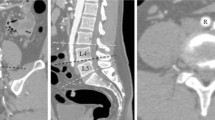Abstract
Purpose
The fluoroscopic computed tomography (CT)-guidance technique increases the accuracy and safety of needle placement for percutaneous lumbar sympathectomy. The aim of the present study was to provide anatomic data from CT images and to discuss the safest route for needle insertion.
Methods
We retrospectively analyzed CT images that were obtained from 25 patients (14 men, 11 women; 37—89 years of age [mean, 68.4 years]) during fluoroscopic CT-guided percutaneous lumbar sympathectomy. The anatomy around the inserted needle was measured and the correlations between patient characteristics and the procedure-related distances were assessed.
Results
The distance from the midline (spinous process) to the entry point and the depth to the target site correlated with body size, especially height and weight. The maximal distance from midline to the insertion point in the range of safe needle insertion at L2 was less than 7.0 cm in approximately 20% of the patients.
Conclusion
The present study was performed to determine the anatomic details required to guide safe percutaneous lumbar sympathectomy based on CT images. The use of CT guidance is recommended for lumbar sympathectomy, especially at the L2 spinal level.
Similar content being viewed by others
References
Tay VK, Fitridge R, Tie ML. Computed tomography fluoroscopy-guided chemical lumbar sympathectomy: simple, safe and effective. Australas Radiol. 2002;46:163–166.
Repelaer van Driel OJ, Van Bockel JH, Van Schilfgaarde R. Lumbar sympathectomy for severe lower limb ischaemia. Results and analysis of factors influencing the outcome. J Cardiovasc Surg. 1988;29:310–314.
Redman DR, Robinson PN, Al-Kutoubi MA. Computerised tomography guided lumbar sympathectomy. Anaesthesia. 1986;41:39–41.
Kuroda M, Koizuka S, Saito S, Sato E, Takizawa D, Goto F. Computed tomography fluoroscopy-guided lumbar sympathectomy for a patient with peripheral vascular disease and lumbar spine compression fracture. J Anesth. 2005;19:268–269.
Bonica JJ. Neurolytic lumbar sympathetic block. In: Bonica JJ, editor. The management of pain. Philadelphia: Lea & Febiger; 1990. p. 2020–2025.
Breivik H, Cousins MJ, Löfström JB. Sympathetic neural blockade of upper and lower extremity. In: Cousins MJ, Bridenbaugh PO, editors. Neural blockade. 3rd ed. Philadelphia: Lippincott-Raven; 1998. p. 411–445.
Ryttov N, Boe S, Nielsen H, Jacobsen J. Necrosis of ureter as a complication to chemical lumbar sympathectomy. Report of a case. Acta Chir Scand. 1981;147:79–80.
Author information
Authors and Affiliations
About this article
Cite this article
Koizuka, S., Saito, S., Obata, H. et al. Anatomic analysis of computed tomography images obtained during fluoroscopic computed tomography-guided percutaneous lumbar sympathectomy. J Anesth 22, 373–377 (2008). https://doi.org/10.1007/s00540-008-0663-x
Received:
Accepted:
Published:
Issue Date:
DOI: https://doi.org/10.1007/s00540-008-0663-x




